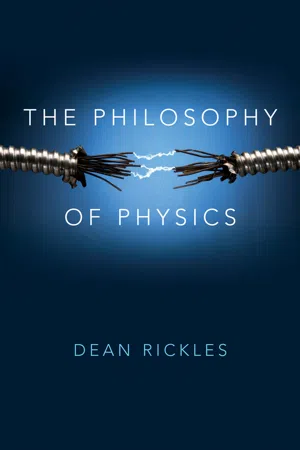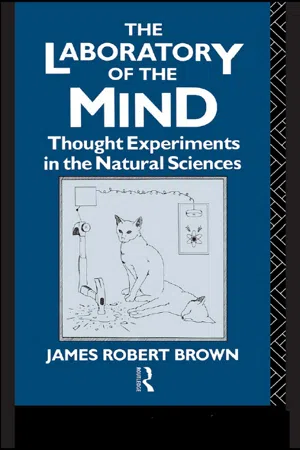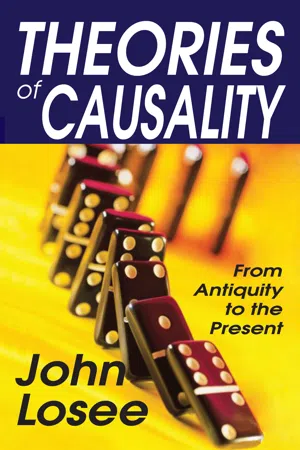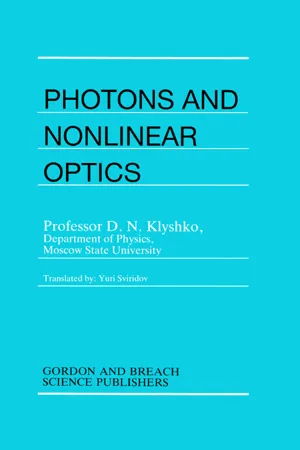Physics
Coherent State
A coherent state in physics refers to a quantum state that exhibits classical-like behavior. It is characterized by a well-defined phase and minimum uncertainty in position and momentum. Coherent states are important in quantum optics and quantum information processing due to their unique properties, such as their ability to minimize quantum noise.
Written by Perlego with AI-assistance
7 Key excerpts on "Coherent State"
Learn about this page
Index pages curate the most relevant extracts from our library of academic textbooks. They’ve been created using an in-house natural language model (NLM), each adding context and meaning to key research topics.
- eBook - ePub
Quantum Implications
Essays in Honour of David Bohm
- Basil Hiley, F. David Peat, Basil Hiley, F. David Peat(Authors)
- 2012(Publication Date)
- Routledge(Publisher)
t)> in the interaction representation can be labelled by:The expectation value in the state |A(x)> of the quantum operator Â(x′) corresponding to the vector potential of electromagnetism is:More generally, if Â(−) (x′) and Â(+) (x′) = (Â(−) (x′))† represent the creation and annihilation operator parts of the quantum operator Â(x′) then:Consequently, by virtue of the Dyson-Wick expansion, the S matrix in a Coherent State is equal to the S matrix in the corresponding classical electromagnetic field:The right-hand side is a vacuum expectation value, the C(−) and B(+) are particle (i.e. non-photon) operators, and S(A(x)) is the S matrix in the presence of the classical electromagnetic field A(x). This result consolidates the close connection between Coherent States and classical fields.A key formula for us will be the matrix element between two Coherent States. For a single mode the formula is: where: is the square of the distance between the two complex numbers, considered as points in a two-dimensional space. This formula generalizes immediately to the Coherent States: where: andThus two Coherent States |A> and |B> can be said to be separated from each other by a distance |A − B |, and a phase Φ, both of which vanish if A = B.Observers and Classical ConceptsIn the Bohr (Copenhagen) interpretation of quantum theory the observer plays a central role; he distinguishes between the classically distinct results of measurements. If before the measurement the state of atomic object plus measuring device is a pure quantum state ψ, then after the measurement the state must (if the environment is ignored) still be a pure state. If the experiment has, for example, two possible results then this pure state ψ′ - eBook - ePub
- David Bohm(Author)
- 2005(Publication Date)
- Routledge(Publisher)
potential and statistical object . This latter is said to correspond to the ‘quantum state of the system’, which in turn corresponds to ‘the wave function of the system’ (or more generally to a vector in Hilbert space). Such usage of language (e.g., to bring in words such as ‘state of a system’) implies that we are thinking of something that has a separate and autonomous kind of existence.The consistency of this way of using language depends to a large extent on the mathematical assumption that the wave equation (i.e., the law governing the changes with time of the wave function, or the Hilbert space vector) is linear. (Non-linear equations for field operations have been proposed but, even here, this is only a limited kind of non-linearity, in the sense that the basic equation for ‘the state vector in Hilbert space’ is always taken to be linear.) Such linearity of equations then allows us to regard ‘state vectors’ as having a kind of autonomous existence (similar in certain ways to that which is attributed in classical field theories to normal modes, but different in that they are more abstract).This complete autonomy of the ‘quantum state’ of a system is supposed to hold only when it is not being observed. In an observation, it is assumed that we have to do with two initially autonomous systems that have come into interaction.7 One of these is described by the ‘state vector of the observed object’ and the other by the ‘state vector of the observing apparatus’.In the consideration of this interaction, certain new features are introduced which correspond to allowing for the possibility of actualizing the observed system’s potentialities at the expense of others that cannot be actualized at the same time. (Mathematically, one can say that ‘the wave packet is reduced’ or that ‘a projection operation takes place’.) - eBook - ePub
- Dean Rickles(Author)
- 2016(Publication Date)
- Polity(Publisher)
What also concerned Einstein was the apparent ‘spookiness’ of the interactions that would happen in distantly separated regions of space if quantum mechanics was supposed to provide a complete representation of reality. Locality was paramount: after all, it had been the central principle of both of his relativity theories in that action at a distance was explicitly ruled out. The notion of an objective reality is linked to this: the values an object has should not be linked to values had by another causally isolated system.A real state (commonly called ‘an ontic state’ in modern discussions) is simply one that exists independently of our measuring it or knowing about it (an ‘element of reality’ in Einstein’s terminology): it is objectively given in the sense that there is a fact of the matter about which values are exemplified at all times. If we measure such a state then we will be finding out what its state was (assuming there is no disturbance) beforehand. The states of a classical mechanical system can clearly be thought of in this way, as revealed by measurement. For example, in a Hamiltonian setting (the classical mechanics in phase space, from §2.2) our (instantaneous) states will be phase points x = (q(t), p(t)), which will determine unique trajectories. Any intrusion of probability here is associated with ignorance, in principle eradicable by supplying the additional information: let’s do the same with quantum probabilities, says Einstein. Assume that the states of quantum mechanics could be filled in by hidden variables.The so-called Kochen–Specker theorem already causes serious problems for the idea that quantum objects possess their properties in a simple ‘common-sense’ way, as suggested by such Einstein-style incompleteness claims. This conception of quantum properties is known as ‘value definiteness’: observables on quantum mechanical systems have definite values at all times, not just when measured. However, given an assumption of non-contextuality (that properties are possessed independently of which measurement we decide to perform), the Kochen–Specker theorem shows that the job of definite value assignments to all properties simply cannot be carried out. This is essentially a formal result having to do with the way observables are represented by Hilbert space operators in quantum mechanics. However, let’s put the Kochen–Specker theorem aside and focus on the famous ‘EPR experiment,’ since this leads us to matters of entanglement and nonlocality. - eBook - ePub
The Laboratory of the Mind
Thought Experiments in the Natural Sciences
- James Robert Brown(Author)
- 2005(Publication Date)
- Routledge(Publisher)
The properties that the system can have, e.g., position, momentum, angular momentum, energy, spin, etc. are called observables (though often there is nothing observable about them) and are associated with operators. Examples in one dimension are: the position operator: X = x, and the momentum operator: P =- ihd / dx. Operators are functions defined on the Hilbert space. For example, if |ψ= e ipx / h then we have P|ψ= ihd (e ipx / h)/ dx = (- ih)(ip / h) e ipx / h = pe ipx / h Figure 24 Whenever an operator, O, has the effect of just multiplying a vector by a real number r, the vector is called an eigenvector of that operator. That is, if O |ψ=r|ψ then |ψ is an eigenvector and r is called an eigenvalue. According to the third principle, only eigenvalues can be the results of any measurement. In the simple example just given, p is an eigenvalue and will be the magnitude revealed on measurement. (At least in the ideal case—it is acknowledged by all that real life is messy.) The state of the system might correspond to one of the eigenvalues, but it need not in general; often it will be in a state of superposition, a linear combination of two or more eigenvectors (which are the basis vectors of the space). The extent to which |ψ overlaps some eigenvector gives the probability amplitude of getting the corresponding eigenvalue as a result of measurement. Generally, the state of the system will change as time passes. This is represented by having |ψ move around in the Hilbert space in a manner governed by the Schrödinger equation. This change of state is smooth and deterministic. When two quantum systems interact they remain ‘entangled’ in some sense, even when far removed from one another. The tensor product of two such states is not a simple product of these two states considered separately. The combined state has some remarkable properties of its own - eBook - ePub
Theories of Causality
From Antiquity to the Present
- John Losee, John Losee(Authors)
- 2017(Publication Date)
- Routledge(Publisher)
α-Particles of given energy and direction, incident upon a sheet of aluminum, are absorbed at varying distances inside the sheet. The law governing this absorption is a statistical law, but since the state description is accomplished without reference to probabilities, this law also is a deterministic law. A further complication is that applications of strong deterministic laws may yield a statistical correlation of results. The laws of Newtonian mechanics, for instance, may be used to predict the distribution of hits on a target produced by firing a relatively rigidly mounted gun. For this experimental arrangement, the extent of scattering can be diminished by improving the mechanism and mounting of the gun. This case contrasts with the case of α-particle absorption. In the latter case, the extent of scattering is irreducible (for a given α-particle energy).The laws of quantum mechanics also are causal laws because they satisfy the requirements of the regularity-between-states view. For example, given information about the energy, mass, charge, and direction of a beam of subatomic particles incident upon a crystal of specified structure, one can calculate from these laws the scattering distribution of the particles of the beam (viz., the relative number of particles as a function of angle of deflection).The laws of quantum mechanics are indeterministic, however. State variables are specified for average properties of ensembles of particles. Alternatively, if a single particle is under consideration, state description is in terms of probabilities. Whereas complete knowledge of a classical system includes statements about the numerical values of each and every state variable, complete knowledge of a quantum mechanical system includes only probability values for the state variables. In the case of a quantum mechanical scattering experiment, one can predict for an individual particle only that there is a certain probability that it will emerge at a particular angle after scattering. Within the context of quantum theory, there is no way to replace the statement of probability by a “more exact” state description. Quantum theoretical state description is, in principle, a specification of probabilities.The regularity-between-states view of causality has several advantages over theories that begin with distinct events and seek to elaborate conditions under which one event is a cause of a second event. The regularity-between-states view provides a unified treatment of deterministic and indeterministic generalizations. In addition, by linking causal relatedness to functional relations between states of isolated systems, one can sidestep questions about nonlocality, action-at-a-distance, and backward causation. What counts for causal relatedness is the success of inferences made about changes in the states of physical systems. - eBook - ePub
- D.N. Klyshko(Author)
- 2018(Publication Date)
- Routledge(Publisher)
β, which are dependent on the field’s parameters.However, the source is usually a macroscopic device with a large number of excited degrees of freedom. For this reason, the vectors |t0 〉ifluctuate from time to time (i is the number of the test). As a result, the readings of the detector fi = 〈t0 |f(t) |t0 〉 are subject to additional fluctuations that can be described by introducing preparation probabilites of some state ρn or other. In such cases, the state of the system is described as mixed (as distinct from the pure states with definite wavefunctions we have examined so far).The common wavefunction | 〉 of the system and source should be considered more rigorously. Let the system of interest A interact (or have interacted) with another system B (e.g., with a thermostat or a source); then no separate wavefunction for A exists. It can easily be shown that all the properties of A can be determined by means of an operator known as the density operator (or the statistical operator). Let the observable f refer to the system A and 〈f〉 = 〈 |f| 〉 be of interest to us. Decomposing the vector | 〉 into eigenvectors |nN〉 = |n〉 |N〉 of some operators (e.g., the HamiltoniansH AandH B, which refer to systems A and B, respectively), we have〈 f 〉 =∑nn ′NN ′〈 | n N 〉 〈 n N | f |n ′N ′〉 〈n ′N ′| 〉=≡∑nn ′Nf〈nn ′n ′N | 〉 〈 | n N 〉SP A(,f ρ)(40) where we have introduced the density matrix of the system Aρ≡n ′n∑ N〈n ′N | 〉 〈 | n N 〉(41) - eBook - ePub
The Entangled God
Divine Relationality and Quantum Physics
- Kirk Wegter-McNelly(Author)
- 2012(Publication Date)
- Routledge(Publisher)
α. The two values are mutually exclusive and exhaustive. The top half of the figure shows two different filter orientations (90º and 45º), along with the two possible polarization values carried by a single photon for each orientation. The bottom half of the figure shows the four possible combinations of 90º-polarization value and 45º-polarization value for a single photon.Now, it may be the case that some particular relation exists between these different polarization properties. A robust theory of photon polarization would provide us with a general account of such relations, but we do not need to develop a robust theory here. We only need to develop a minimal account of polarization that accords with the particulate nature of photons and abides by our classical intuitions. This means that for the remainder of the chapter we will assume, in accord with property definiteness, that each photon carries with it a distinct and definite polarization value for each possible polarization measurement even before any measurement occurs.Let us now turn to the principle of “state separability.” At the root of this principle is the notion of spatial separation (or what is commonly called “distance”). Physical objects that exist in separate places do so separately from one another and must therefore have separately describable states.8 It sounds almost too obvious to mention, but it is a fundamental presumption that needs to be articulated. Einstein expressed his understanding of this principle in the following way: “An essential aspect of … physics is that [physical objects] lay claim, at a certain time, to an existence independent of one another, provided these objects ‘are situated in different parts of space’” (Born 1971, 170). Separable states are commonly referred to as “product” states because they can be expressed as the mathematical product of two distinct state descriptions, each of which resolves to a claim about a single object. A concrete example will help clarify the idea.Let us consider a physical system composed of two photons, A and B. In a fully state-separable world one can always say that photon A over here has its own α-polarization state A, say, A=Tα , and that photon B over there has its own β-polarization state B, say, B=Tβ . The subscript α indicates that we are talking about the polarization state of photon A, whereas the subscript β indicates that we are talking about the polarization state of photon B. The joint system composed of these two photons—we will call it C—will then have a joint αβ-polarization state, C, that is fully “partitionable” or “separable” in terms of the individual polarization states of A and B. Mathematically speaking, C will be “factorizable” in the sense that it can be factored into an expression where all of the information about photon A is grouped separately from all of the information about photon B. In the present example, this is the case trivially because the state of system C can be written as C = A⊗B = Tα ⊗Tβ . We use a special symbol (in this case, “⊗”) to remind ourselves that whatever appears immediately to its left will always refer to photon A and immediately to its right to photon B. (The expression “Tβ ⊗Tα ” is not licit because we have stipulated that β refers to the polarization state of photon B, which must always appear on the right, and that α refers to the polarization state of photon A, which must always appear on the left.) The presence of only one ⊗ in the description of this joint-polarization state marks it as a “product” state, i.e., a joint state whose individual states are fully separable (the individual state of each photon can be written separately). To find the likelihood of system C being in the joint state Tα ⊗Tβ we simply multiply the likelihood of photon A being in Tα with the likelihood of photon B being in Tβ






